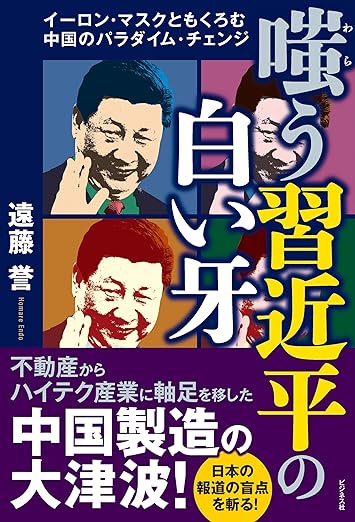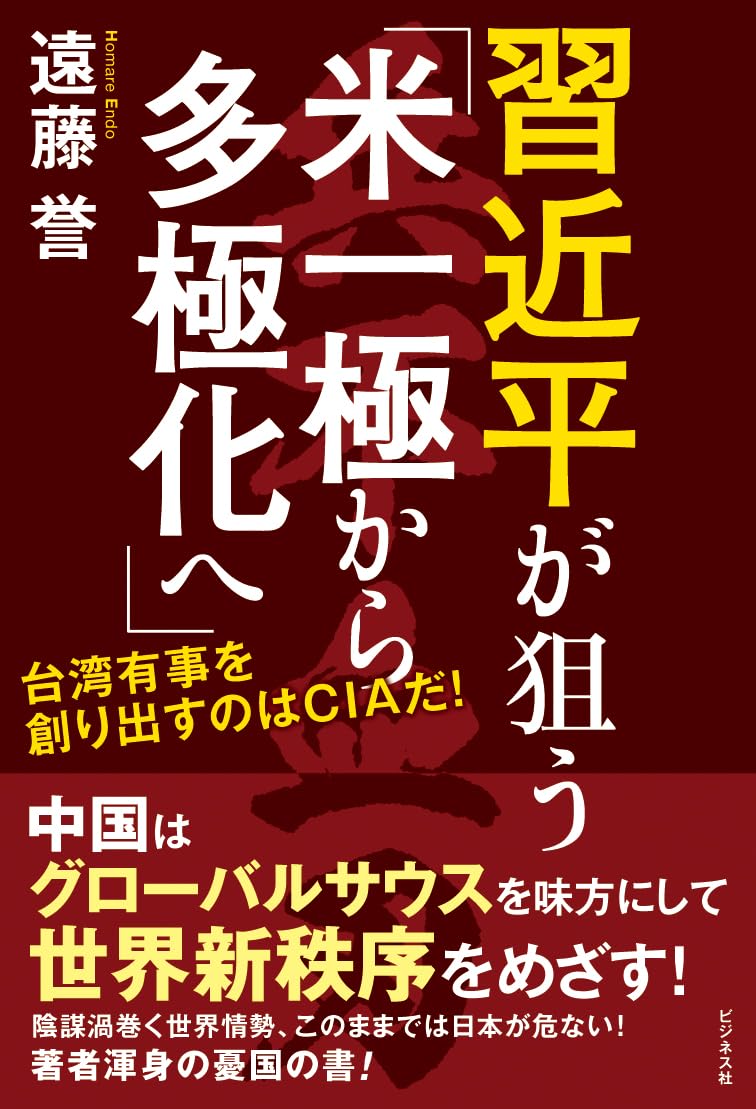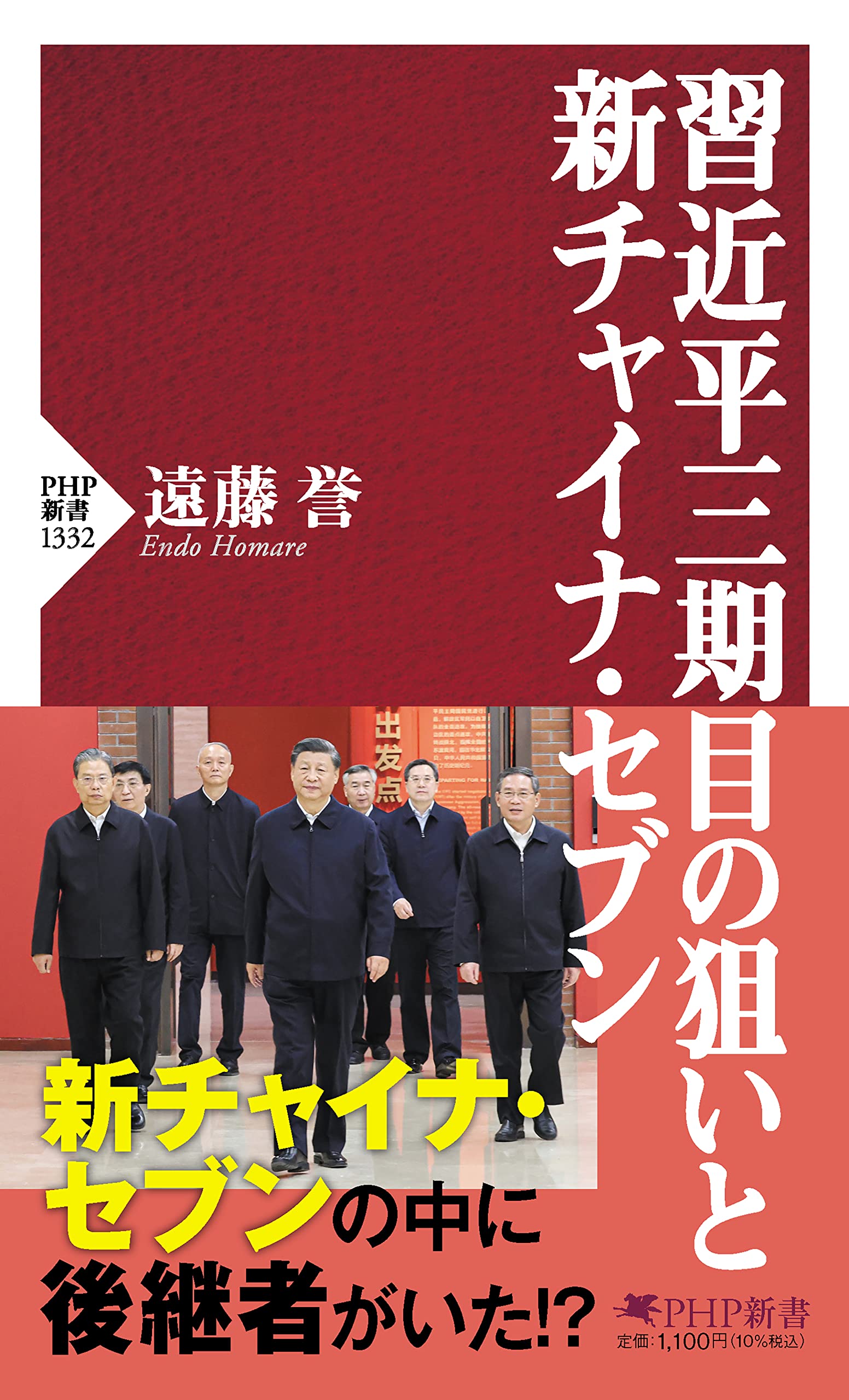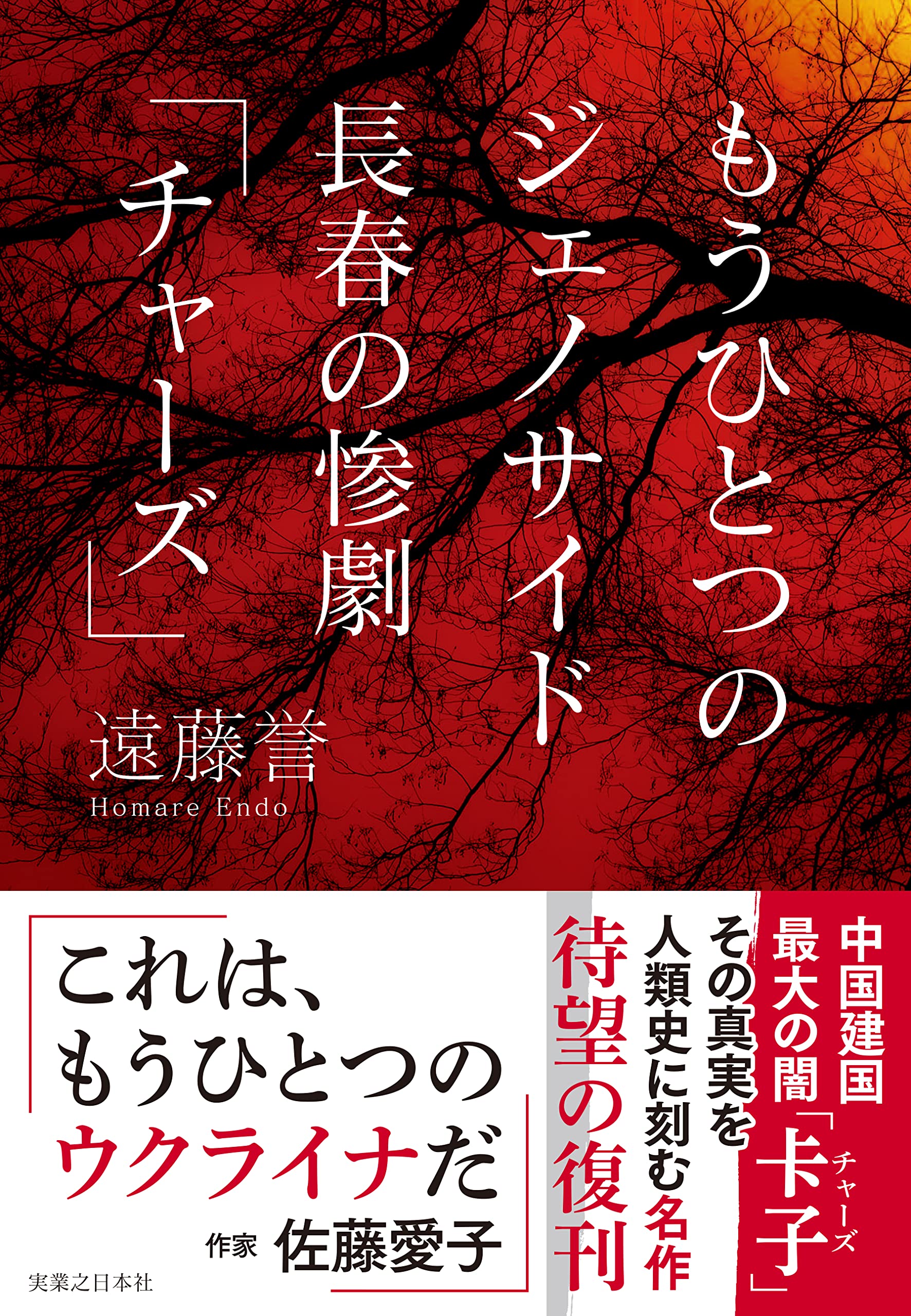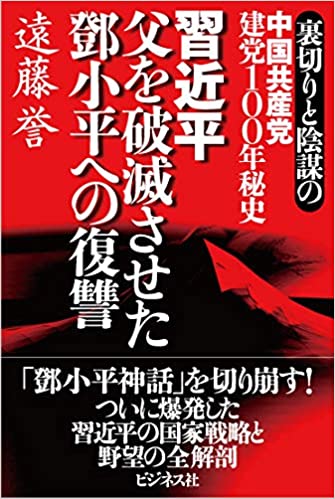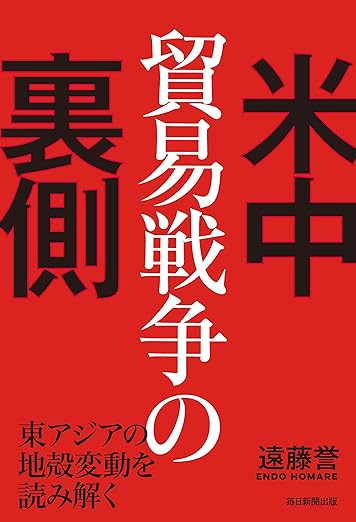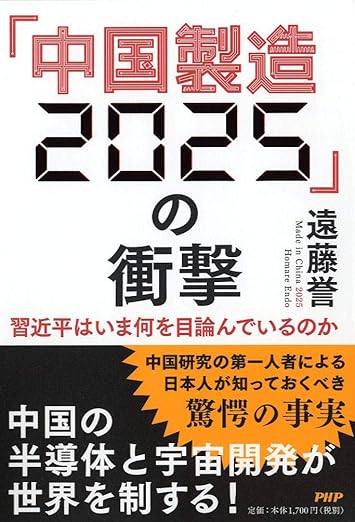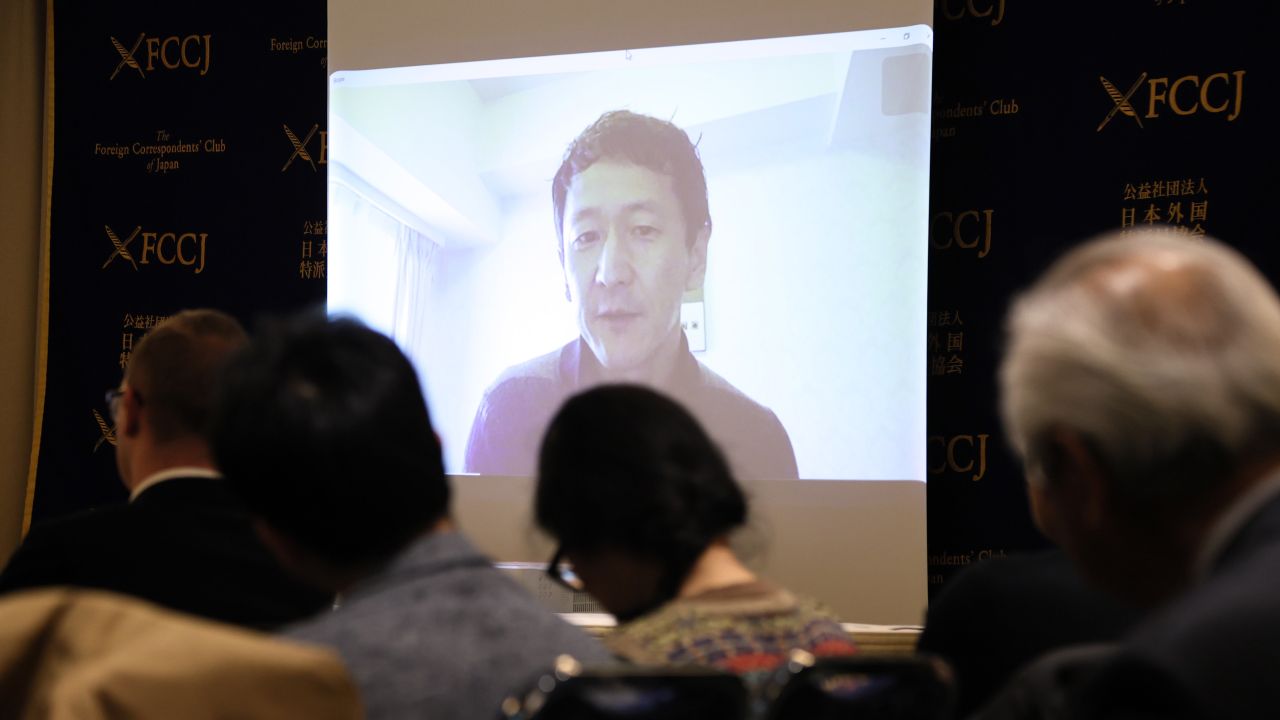
The spread of the coronavirus infection in Japan closely resembles what happened in the initial phase of the coronavirus outbreak in Wuhan. The mass infections on board a cruise ship and passengers testing positive for the coronavirus after disembarking from the ship are just some events that closely follow what happened in Wuhan. If Xi Jinping is the true culprit behind the virus that has driven the whole world to fear, then it is the Abe government that has plunged all of Japan into horror. Are the lives of the Japanese people only a secondary consideration?
Initial phase of the coronavirus outbreak in Wuhan
By “initial phase,” I mean the period after Xi Jinping issued his “important instructions” on January 20, not when the first cases of pneumonia with an unknown cause broke out. (For details, please see my January 24 column, “Why did it take Xi Jinping so long to deal with the novel coronavirus?”)
When the important instructions were issued, the residents of Wuhan were fearful and afraid. People who had the suspected symptoms rushed to local hospitals in large numbers and elderly people with high fevers tried to call ambulances. However, Wuhan had only around 50 ambulances at this time, and hospitals had very few rooms. Patients suspected of having the new virus were forced to wait outside hospitals for more than five hours in the cold weather, giving rise to cross infections that caused a panic.
Initially, there was a shortage of doctors, and diagnoses of the novel coronavirus were not made unless a Polymerase Chain Reaction (PCR) test (a testing method involving highly sensitive detection of trace amounts of specimens) was performed. For this reason, many patients had no choice but to self-quarantine themselves at home.
However, the authorities rushed to build container hospitals (quarantine hospitals for emergency treatment made of prefabricated containers, similar to field hospitals). The first such container hospital was completed on February 5. Not only does Wuhan now have 13 container hospitals, but 32,000 medical staff all over the country have been dispatched to Wuhan, including medical units from the People’s Liberation Army.
Patients with a shadow on their lungs in CT scans are now classified as coronavirus patients, in addition to those testing positive in a PCR test. Therefore, although the number of patients has increased, a diagnosis on whether or not a patient has the novel coronavirus can be made immediately. Two or three days ago, an acquaintance of mine in Wuhan went to a hospital because of health concerns, received a checkup right away and was given a clean bill of health.
The situation in Japan
How, then, do these conditions compare with the situation in Japan? On February 17, the Ministry of Health, Labour and Welfare announced that at the Novel Coronavirus Expert Meeting held on February 16, guidelines had been determined for people to contact consultation offices for returnees from China or those who have come in close contact with people with the coronavirus. The guidelines state that people should call the consultation offices if they have flu-like symptoms and a fever of 37.5 degrees Celsius or higher that continue for at least four days (at least two days or more for people at higher risk, such as the elderly).
People who have to live with the unease of “possibly having the coronavirus” for four days while suffering a fever of 37.5 degrees Celsius or higher must bear considerable mental hardship and physical exhaustion. During that time, they will face a variety of negative impacts in their daily and social lives. At the Novel Coronavirus Expert Meeting, the panel said that “we have shifted from a phase of border control measures to a phase where we must build a medical response system that will prevent serious conditions and the spread of infection.” As I noted in my February 20 column, “Japan’s ‘Border Control Failure’ Triggered by Appeasement on Xi Jinping’s Visit as a State Guest to Japan,” having failed decisively at controlling the spread of the virus at the border, Japan now also runs the risk of falling more and more behind in preventing patients from developing serious symptoms.
What I find more frightening than anything else is this: Not only did the Japanese government effectively turn the Diamond Princess cruise ship into a giant petri dish for the coronavirus, but it also allowed passengers who had disembarked after testing negative for the coronavirus to return home using ordinary public transportation. All countries other than Japan have imposed an additional mandatory 14-day quarantine on their citizens after they had disembarked from the ship and had been repatriated to their home countries on specially chartered flights.
Meanwhile, several Diamond Princess passengers from various countries including Japan have tested positive for coronavirus immediately after they disembarked from the ship, even though they had previously tested negative. Besides this, something very unusual was found among some of “the passengers assessed as negative when disembarking from the ship.” It was found that, after getting off the ship, 23 of these passengers had been assessed based on results from tests carried out on February 5, and had not actually been tested before they got off the ship.
How could the Japanese government be so grossly incompetent?
It goes as far as to raise serious doubts in my mind as to whether the Japanese government is truly committed to protecting the lives of the Japanese people.
Dr. Iwata exposes conditions inside the cruise ship
I was particularly astonished to learn about the horrible conditions on board the Diamond Princess cruise ship.
Since many Japanese people and other people around the world are already familiar with the conditions on board the ship, I will not write about this in extra detail. Here are the main facts. At around 9:00 p.m. on February 18, Professor Kentaro Iwata of the Kobe University Hospital Division of Infectious Diseases posted whistleblower videos to YouTube both in Japanese and English. Professor Iwata’s main message was that the conditions on board the Diamond Princess were completely chaotic and hazardous. There was no distinction between infection-free “green zones” and potentially contaminated “red zones.” From the moment the videos were posted to the early morning of February 19, the YouTube videos spread quickly to news media outlets in Japan and the rest of the world (CNN and BBC), creating a huge buzz internationally.
Thereafter, it can be “inferred” that Professor Iwata felt pressured by the Japanese government. Mr. Iwata was ordered off the cruise ship after spending only two hours on board, and he deleted his videos from YouTube. This attracted even more attention. Mr. Iwata held a press conference at The Foreign Correspondents’ Club of Japan. A large number of people viewed extensive coverage on related information in Japanese, such as this video and the following reporting (“Kentaro Iwata’s Videos Inspire Cruise Ship Staff to Break Their Silence: ‘Mr. Iwata Acted as a Spokesman for Staff Who Were Not Permitted to Speak Out’”)
At 10:00 a.m. on February 19, Gaku Hashimoto, State Minister of Health, Labour and Welfare, posted a tweet in an attempt to refute Professor Iwata’s whistleblowing claims. However, the tweet backfired and only served to prove that Professor Iwata’s claims were correct, sparking an eruption of online criticism against the government’s handling of the cruise ship.
In response, State Minister Hashimoto rushed to delete the tweet he had posted, which included a photo of conditions aboard the ship.
However, that photo had already been downloaded by many Internet users and can still be viewed now. Just in case, I have attached the photo below.
This photo was presented as proof that zoning (separation of areas) inside the ship had been implemented. It shows that the signs indicate that “the door to the right leads to the contaminated (hazardous) area,” while “the door to the left leads to the clean (safe) area.” However, anyone can easily see that the zones were separated in a very sloppy way. It’s safe to assume that this is probably why Mr. Hashimoto deleted the image from Twitter.
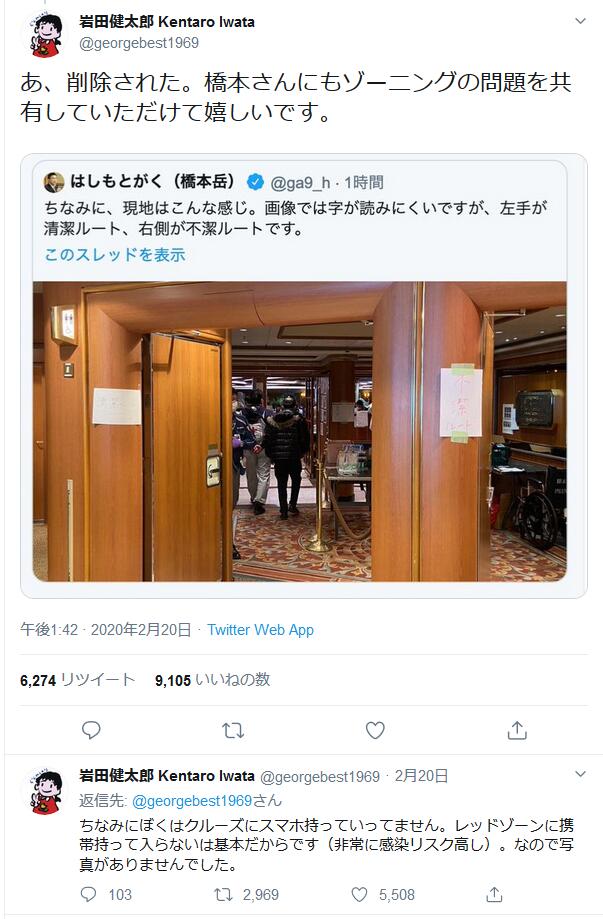
Twitter Text:
Kentaro Iwata: “He has deleted his tweet. I’m glad that Mr. Hashimoto had the chance to share the zoning problem with all of us.”
Gaku Hashimoto, 1 hour ago: “Incidentally, here’s what conditions were like on board the ship. It’s a little hard to tell what the signs say in the image. The left side is the clean route, the right side is the contaminated route.”
Kentara Iwata, February 20: “By the way, I didn’t bring my smartphone with me on the ship. One basic principle of infection control is to never bring a smartphone into a red zone. (There is a very high contamination risk.) That is why I didn’t have any photos to share.”
Here is a link to a website where you can view a virtual tour of what it is like inside the Diamond Princess. If you click on the screen and proceed forward by clicking on about three arrows, you will advance to the position where Mr. Hashimoto took the photo he posted on Twitter. He had boasted that “zoning was fully implemented aboard the ship,” but it turned out that this “zoning” consisted of no more than these two flimsy pieces of paper taped on the doorways, indicating “clean” and “contaminated.” This revelation caused another major frenzy overseas.
The Chinese Internet: Dr. Iwata is “Wuhan’s Dr. Li Wenliang”
In response to these events, the most frequent comment on the Internet in China, the source of the novel coronavirus, has been the following:
“Kentaro Iwata is China’s Li Wenliang.”
Li Weliang is the doctor in Wuhan whom I wrote about in my February 13 column titled “Suppression of Free Speech and Appeasement Can Kill People—Reflections on Xi Jinping’s Third Television Appearance.” In a group chat with fellow doctors on December 30, Dr. Li sounded the alarm by writing, “The seafood market in Wuhan is dangerous. Lots of pneumonia cases have been steadily reported from the market. What’s more, the cases are similar to a SARS-like coronavirus.” For this, he was summoned and admonished by the Wuhan Public Security Bureau. On February 7, Dr. Li died as a result of the novel coronavirus.
The Chinese Internet praised Dr. Iwata as “a hero.”
Having done so, Chinese netizens shared comments like the following:
- Japan is reenacting events in China.
- Why doesn’t Japan learn from the failures in Wuhan?
- It turns out the bureaucrats in Japan are just as incompetent as those in Wuhan!
The Chinese Internet abounded with highly critical comments.
Why did Japan turn the cruise ship into a petri dish for the virus?
Japan’s border control measures failed because the country didn’t do enough out of consideration for the Abe government’s invitation of Xi Jinping as a state guest to Japan. I’ve discussed this in detail in “Japan’s “Border Control Failure” Triggered by Appeasement on Xi Jinping’s Visit as a State Guest to Japan.” However, why did the Japanese government respond in such an inept way to so many things, including the cruise ship situation? I was wondering if there could be any reasons other than “government incompetence,” “opaque bureaucrats” and “efforts by the Abe government to downplay the negative impact of the novel coronavirus.” That is when I found a tweet that surprised me. It was a tweet by Keizo Takemi, a member of the House of Councillors, who has previously served as Senior Vice-Minister of Health, Labour and Welfare and Parliamentary Secretary for Foreign Affairs. In his tweet, Mr. Takei stated the following:
“Doubts have been raised about whether the government really did enough to prevent the spread of infection on board the cruise ship. The most important goal of this operation was to stop people carrying the coronavirus—of whom there were an unknown number among the 3,700 cruise ship passengers—from entering Japan and spreading the virus within the country. The Japanese government successfully achieved this particular goal! (10:03 p.m., February 20, 2020).
I believe that this tweet reflects the Japanese government’s true intentions.
There were many Japanese people among the cruise ship passengers. However, the Japanese government failed to properly treat the Japanese passengers aboard the cruise ship as “Japanese citizens” it was responsible for, and took the approach that as long as “the Japanese government could not be held directly responsible for” any further increase in the number of coronavirus patients on shore, everything would be fine. I believe that this approach represents nothing other than a flagrant disregard for human life.
Built in Nagasaki, Diamond Princess is a large cruise ship that undertakes cruises from ports in Japan, where it departs and returns from voyages. Diamond Princess is owned by P&O (Peninsular and Oriental Steam Navigation Company) of the U.K. and falls under Carnival Corporation & plc, which is headquartered in the U.S. Also, Carnival Corporation is the world’s largest operator of cruise ships. According to 2011 data, Carnival Corporation was a dominant market force with a market share of 49.2%.
This is bound to raise the question of which country is responsible for the cruise ship situation.
Generally speaking, as long as a cruise ship is quarantined at port, the companies involved with the cruise ship will incur losses. However, if the passengers are allowed to disembark from the ship, the companies involved with the cruise ship will no longer be held responsible for them. For this reason, it is possible that the companies that own and operate the Diamond Princess cruise ship persuaded the U.S. government to put pressure on the Japanese government, which had been sitting on its hands and had not been transparent, to allow the passengers to disembark from the ship. I suspect that the Japanese government, after realizing that it had caused a mass infection among the cruise ship passengers, must have rushed to allow the passengers to disembark from the ship.
In a dialogue with the author (included in “Gekitotsu! Endo Vs. Tahara Nicchu to Shu Kinpei Kokuhin” (Homare Endo Versus Soichiro Tahara: Debate on Japan-China Relations and Inviting Xi Jinping as a State Guest to Japan), journalist Soichiro Tahara boldly asserted that “I’m completely in favor of Xi Jinping’s visit as a state guest to Japan!,” citing the following as his reason: “Japan is great because it keeps the same distance between the U.S. and China, thereby remaining a neutral partner of both countries.” I can’t help but see a common thread linking this attitude with Japan’s recent failure at measures to control the coronavirus at the border and its inept handling of the cruise ship situation.
Mr. Tahara also said that he had recommended to Toshihiro Nikai, Secretary-General of the Liberal Democratic Party, that Xi Jinping be invited as a state guest to Japan.
Although they are free to express what they want, journalists are normally supposed to maintain an impartial position with respect to the government. Here, a journalist is being friendly with a key person in the ruling party and only sharing words of admiration for the government. Mr. Tahara’s remarks made me think deeply about “democracy and the fundamental roles of journalists in Japan.”
I also discussed these topics in detail on Patriot TV.
This piece was originally published by the author on Yahoo! News.
カテゴリー
最近の投稿
- 欧州が抱える中国問題
- 台湾有事で米軍の援軍はあり得るか? トランプ2.0とバイデン政権の対台湾武器提供の比較から
- Europe’s China Problem
- 日本の戦略的転換と、インド太平洋抑止に台湾が果たす新たな重要性
- トランプ氏の習近平・高市両氏への電話目的は「対中ビジネス」 高市政権は未だバイデン政権の対中戦略の中
- 中国の「高市非難風刺画」は「吉田茂・岸信介」非難風刺画と同じ――そこから見える中国の本気度
- 中国の高圧的な日本叩きに対して日本が持っているカード
- 高市発言に習近平はなぜここまで激怒するのか? 日本は台湾問題を口実にせず防衛力に戦略を
- Japan’s Strategic Turn and Taiwan’s New Centrality in Indo-Pacific Deterrence
- 中国の第15次5カ年計画の建議に見る政治経済の転換:成長のナラティブから安全保障を基軸とした統治へ




